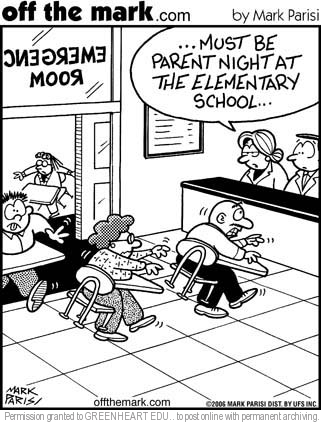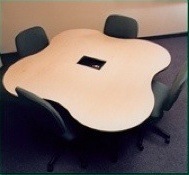Furnishing the Optimal Learning Environment
Why aren't we furnishing the optimal learning environment? If we want students to behave appropriately and engage fully in their learning, why do we seat them in fast-food restaurant desks that are designed to move people out quickly? Why can't classrooms be more like home, where children learn naturally and continually? Why do we not consider student health, comfort and emotional and physical well-being when considering what they
sit in for several hours per day?

To make the best, most sustainable choices for new or renovated schools, an evaluation of alternative building materials and construction methods provides invaluable information. If this evaluation is to be complete, it will include school furniture, since chairs, desks and tables take up more classroom space than any other product.... School furniture has an impact on the indoor air quality and overall sustainability of new or renovated schools.
— Bob Roskos
BASELINE CRITERIA FOR FURNISHING THE OPTIMAL LEARNING ENVIRONMENT
- Ensure that furnishings are:
- manufactured according to sustainability principles (eg, fair labour practices)
- made of non-toxic, preferably natural, materials (eg, no VOCs emitted)
- sustainably harvested/certified or recycled wood
- locally sourced/manufactured, whenever possible
- recyclable or biodegradable materials
- reusable "products of service" (eg, leased Interface carpet tiles)
- not light, not dark in colour (so dirt shows less)
- cleanable, durable and/or replaceable
- easy to maintain using non-toxic cleaning materials
- Wherever possible, carpet the floors (research shows higher achievement in carpeted classrooms, probably due to better acoustics), with attention to issues of dust and allergies.

- Carefully consider desk design:

- to enhance group interaction with each other and with technology (eg, puddle desks, or other special designs)
- to physically accommodate the size of students so that bodies don't intrude upon public space or others' "territory" (eg, adjustable height desks)
- to allow flexibility in seating arrangements through movable seating that is suited to the flooring, and easy and quiet to move (with casters that do not roll too fast!)
- Plan counter height and recessed surface outlets where needed.
- Ensure the line of sight (teacher to students, and students to teacher/boards) for all uses of the classroom:
- correct configuration of audiovisual equipment projection
- different seating arrangement possibilities
- set up with appropriate orientation to daylight to avoid glare on screens and other surfaces
- Provide ample and accessible storage (eg, hooks or "cubby holes") for student book bags (to create a sense of personal space) and bookcases for resource books (to encourage rich learning)
- ensure that students have access to lockable storage large enough for laptop computers
- Provide ample, accessible display opportunities:
- for sharing student work, making it visible and valued
- for posting rules/schedules/notices as reminders that students are part of a community
- with access to power supply/data connectivity for interactive media
- be sure that surface colours won't compete with exhibited materials

At school, only the quality of teacher is a greater determinant of student success than the environment. Environments can be nourishing or toxic, supportive or draining. Environments are never neutral.
— Eric Jensen
Return to Greening Facilities
Go to School Greening
Visit the GreenHeart Education Homepage
|




